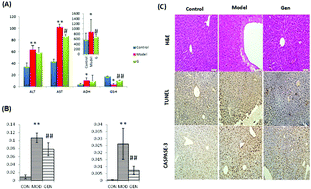High-throughput metabolomics approach reveals new mechanistic insights for drug response of phenotypes of geniposide towards alcohol-induced liver injury by using liquid chromatography coupled to high resolution mass spectrometry†
Abstract
Alcohol-induced liver injury (ALD) shows obvious metabolic disorders, categorized by a wide range of metabolite abnormalities. High-throughput metabolomics technology appears to be an appropriate solution. In this study, a urine metabolic profile was assessed using a UPLC-Q-TOF/HDMS (liquid chromatography coupled to high resolution mass spectrometry) approach to investigate the underlying molecular mechanisms of ALD and the therapeutic effect of geniposide. The endogenous low-molecular-weight metabolites in the mouse model of ALD were observed and 48 specific biomarkers were identified. Geniposide was found to have a regulatory effect on 32 of them. Furthermore, targeted analysis of biomarkers showed clear separation between the model and geniposide treatment group. Fifteen biomarkers with high contribution to group differentiation were screened out. Also, a comprehensive analysis of a significant disturbance of multiple metabolic pathways indicated that geniposide could modify abnormal metabolism due to ethanol exposure, during which disorders relating to amino acid metabolism and the oxidative stress state could be alleviated. At the same time, accessory examinations, including plasma biochemical indicators and liver tissue pathological analysis, showed similar results. It was suggested that geniposide was effective as a hepatoprotective agent against ethanol-induced liver damage by re-balancing a wide range of metabolic disorders.


 Please wait while we load your content...
Please wait while we load your content...